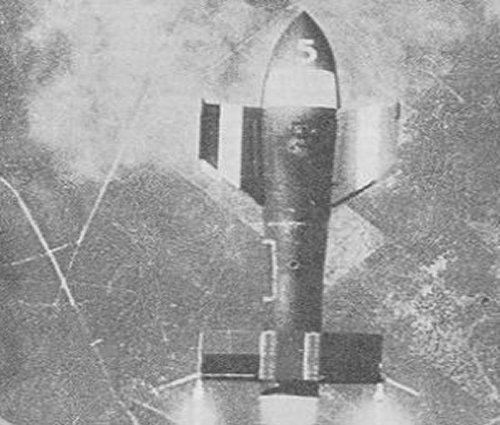
In Service: 1943 to 1945
First Flight: Manufacturer: Ruhrstahl Number built:
Type: Anti-ship Missiles Guidance system: radio controlled Length: 3.30 m Wingspan: 1.40 m Diameter: 0.56 cm Weight: 1,362 kg Engine: none Maximum speed: 1,235 km/h Range: 5 km Warhead: 300 kg amatol Fuze: Launch Platform: Do 217, He 177 Operators: Luftwaffe Variants: Other: Missiles Articles:
The Ruhrstahl X-1 (Fritz X) was a glide bomb. Designed and developed by Ruhrstahl AG in 1943 under the leadership of Dipl.-Ing. Max Otto Kramer. The Ruhrstahl X-1 was known by a number of different names, Ruhrstahl SD 1400 X, Kramer X-1, PC 1400X, FX 1400, Fritz X. This weapon was intended to be deployed against armored ships such as heavy cruisers, battleships. Dipl.-Ing. Max Otto Kramer had been experimenting since early 1938, with remote control freefalling bombs and in 1940. Kramer joined Ruhrstahl. The Ruhrstahl X-1 (Fritz X) had four centrally mounted stub wings and the box shaped tail unit it also had a pointed nose which greatly increased its aerodynamic properties. the preferred release height for this missile was 5,500 m but it could be released at a height of 4,000 m and released approximately 5 km from the target of course visibility needed to be good as it was operator controlled via the Kehl-Straßburg system, the Fritz X could penetrate 130 mm of armour plate. The Ruhrstahl X-1 (Fritz X) was controlled by the operator in the carrier aircraft using a radiolink Kehl-Straßburg (designed and developed by Telefunken) the operator had to keep the target in sight at all times, to aid the operator in this a flare was ignited in the tail of the bomb so it could be seen from the carrier aircraft. The launch platform was a Do 217 however. It could be risky launching a Ruhrstahl X-1 (Fritz X) because the carrier aircraft had to decelerate before launching the missile as well as flying on a steady course right up until the missile hit its target, which left the carrier aircraft vulnerable to enemy fighters also there was a possibility of the missile becoming subject to electronic countermeasures. The Ruhrstahl X-1 (Fritz X) was first used operationally on 21 July 1943 by III./KG 100 flying Do 217 in a raid on Augusta harbor in Sicily 9 September 1943 the Ruhrstahl X-1 (Fritz X) was used against the Italian naval fleet, after they signed the armistice with the Allies. the Italian battleship Roma was hit and destroyed, also her sistership a battleship, Italia was badly damaged. 11 September 1943 the Ruhrstahl X-1 (Fritz X) was used during the invasion of Salerno and the light cruiser Savannah was badly damaged also the Philadelphia suffered a near miss but damage was still caused. 13 September 1943 the light cruiser HMS Uganda, was severely damaged by a Ruhrstahl X-1 (Fritz X) missile. 16 September 1943. The British battleship HMS Warspite was severely damaged by a Ruhrstahl X-1 (Fritz X) missile. 17 September 1943. The American light cruiser Philadelphia was lightly damaged from near misses from a Ruhrstahl X-1 (Fritz X) missile.
The Warplanes of the Third Reich. ISBN-10: 0385057822 German Aircraft of the Second World War. ISBN-10: 0370000242 Hitler's Luftwaffe. ISBN-10: 051718771X For a complete list of sources
|
| |||||||||||||||||||||||||||



